The history of lipstick dates back thousands of years, evolving through various civilizations, social norms, and technological advancements. Its use has shifted from cultural and religious significance to a fashion statement and expression of individual style. Here’s a detailed history of lipstick from ancient times to the modern era:
1. Ancient Civilizations
Mesopotamia (Sumerians, c. 3500 BCE)


- Early Evidence: The Sumerians are often credited as the earliest users of makeup, including lip color. They would crush gemstones and apply them to their lips and around their eyes to add shine and color.
- Ingredients: Early forms of lipstick were made using natural substances like crushed insects (carmine), red ochre (an iron oxide), and plant extracts.
Ancient Egypt (c. 3000 BCE)

- Cultural Significance: Both men and women in Ancient Egypt wore lip color to denote social status. Red lips were considered a mark of distinction and power, and the use of cosmetics was linked to religion and spiritual protection.
- Famous Figures: Queen Cleopatra is said to have used lipstick made from crushed ants and carmine beetles to create a deep red hue. Other ingredients included red ochre and various fats.
- Ingredients: Egyptian lipsticks were often made with a base of natural oils or animal fat combined with red ochre, carmine (from insects), or plant-based dyes.
Ancient Greece and Rome (c. 1000 BCE – 500 CE)

- Greece: In ancient Greece, the use of lipstick was initially associated with prostitutes, who were legally required to wear specific shades to differentiate themselves. However, over time, lip color became more accepted among wealthy women.
- Rome: Roman women of high status used lip color to enhance their appearance. They would often use plant-based dyes, like mulberry, and a mix of red wine sediment with animal fat. Lipstick here also had medicinal purposes, such as lip balms made from beeswax and natural oils to treat chapped lips.
2. Medieval and Renaissance Periods
Medieval Europe (500 – 1500 CE)

- Church Opposition: During the Middle Ages, the Christian Church disapproved of makeup, associating it with deceit, vanity, and immoral behavior. Lipstick was often linked to witchcraft or sinful behavior, and wearing it could lead to accusations of sorcery.
- Limited Use: Despite religious restrictions, some women continued to use subtle tints made from herbal and floral extracts to add a faint color to their lips.
Renaissance (14th – 17th Century)

- Revival of Cosmetics: During the Renaissance, particularly in Italy and France, lipstick and other cosmetics regained popularity, especially among the aristocracy. Red lips became fashionable again, symbolizing youth and beauty.
- Queen Elizabeth I: One of the most famous figures associated with lipstick was Queen Elizabeth I of England (1533–1603). She popularized the look of pale skin and bright red lips, which were made using a mixture of beeswax and red dyes. At that time, lipstick was believed to have healing properties, and Elizabeth herself reportedly wore it as a remedy for illness.
3. 18th and 19th Century Europe and America
18th Century (1700s)

- Social Divide: In the 18th century, lip color was primarily worn by actors, courtesans, and women of lower social status. The upper classes, particularly in Britain, frowned upon the use of cosmetics.
- Lipstick as a Political Statement: In France, lipstick remained fashionable at the royal court, especially before the French Revolution. Women like Marie Antoinette wore bold lip colors to signify wealth and status.
19th Century (Victorian Era, 1800s)

- Cosmetic Taboo: During Queen Victoria’s reign, makeup was largely considered vulgar and inappropriate for “respectable” women. Lipstick and makeup were mainly used by actresses and prostitutes. The idea of natural beauty dominated, and artificial enhancements were condemned.
- Homemade Remedies: Some women secretly used home-made lip stains from plant dyes like beetroot or berries, applying them subtly to achieve a natural-looking flush.
4. Early 20th Century (1900 – 1950)
Emergence of Modern Lipstick

- 1900s: The first commercially available lipsticks emerged around the early 20th century. These lipsticks were initially sold in pots and paper tubes. In 1915, Maurice Levy invented the first “push-up” metal lipstick tube, revolutionizing the convenience of applying lipstick.
- Suffragette Movement: Lipstick became a symbol of female empowerment in the early 1900s, especially during the suffragette movement. Women like Elizabeth Arden handed out tubes of bright red lipstick to suffragettes as a symbol of defiance and independence.
Golden Age of Hollywood (1920s – 1940s)

- 1920s: The invention of motion pictures and the rise of Hollywood stars popularized makeup trends, including lipstick. Flappers of the 1920s wore dark red lipstick as a sign of rebellion against traditional norms.
- Iconic Shades: During the 1930s and 1940s, actresses like Greta Garbo and Marilyn Monroe helped solidify the trend of bright red lips. Brands like Max Factor and Elizabeth Arden launched iconic lipstick shades, which became must-haves for women.
- Wartime Innovation: During World War II, lipstick was marketed as a morale booster. Despite shortages of many goods, lipstick production continued, with packaging shifting to metal-free alternatives due to material restrictions.
5. Late 20th Century (1950 – 1990)

1950s: The Red Lip Era
- Cultural Influence: The 1950s were dominated by red lips, popularized by Hollywood stars like Marilyn Monroe, Grace Kelly, and Elizabeth Taylor. Women’s magazines and beauty advertisements emphasized the allure of bright red lipstick as part of a glamorous and sophisticated image.
- Post-War Prosperity: Lipstick sales skyrocketed as the economy improved after WWII, and new formulations emerged, including long-lasting and smudge-proof varieties.
1960s – 1970s: Shifting Trends

- 1960s: Lipstick shades became more diverse, with pastel colors like pale pinks and corals becoming fashionable, influenced by the mod and hippie movements. Iconic figures like Twiggy embraced these new, lighter shades.
- 1970s: Natural beauty trends gained popularity, and women began to prefer neutral or nude shades. However, bolder colors like deep plums and browns were also popular with the rise of disco and punk subcultures.
1980s: Bold and Bright

- Vibrant Colors: The 1980s were all about excess, with women wearing bold, bright lipsticks, such as hot pinks, fuchsias, and purples. Brands like Revlon, L’Oréal, and MAC became popular for offering a wide range of vibrant colors.
- Power Dressing: As more women entered the workforce, lipstick became part of the “power dressing” ensemble, with bold lip colors often seen as a way to convey confidence and assertiveness.
6. 21st Century (2000s – Present)
Diversity and Innovation

- New Formulations: In the 2000s, lipstick formulations continued to evolve, offering long-wear, hydrating, and transfer-proof options. Matte, glossy, and satin finishes became widely available.
- Vegan and Natural Products: There has been a growing demand for vegan, cruelty-free, and eco-friendly lipstick products, with brands focusing on sustainable ingredients and packaging.
Cultural Shifts

- Social Media and Beauty Influencers: The rise of social media has significantly influenced lipstick trends, with beauty influencers and celebrities driving demand for specific shades and finishes. Viral trends and makeup challenges have made lipstick more accessible and experimental.
- Inclusivity: Modern lipstick brands have expanded their shade ranges to be more inclusive, offering a wide variety of colors suitable for all skin tones, thanks in part to influential brands like Fenty Beauty.
Conclusion
Lipstick has evolved from ancient rituals and cultural practices into a powerful symbol of beauty, fashion, and self-expression. Its history reflects broader social and cultural changes, with shifts in color, texture, and purpose that mirror changing attitudes towards gender, beauty, and individualism. Today, lipstick continues to be a key product in the cosmetics industry, cherished by millions worldwide.




